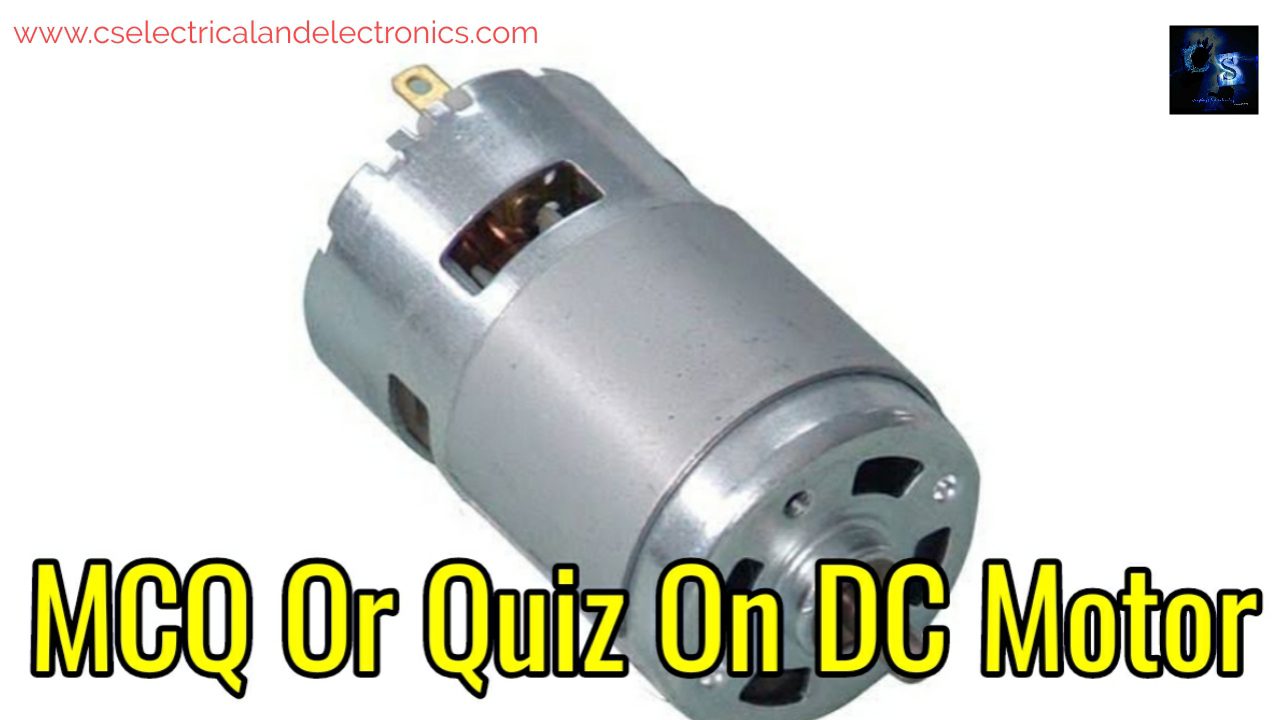DC Motors MCQ Or Quiz, Electrical Objective Questions
Hello guys, welcome back to my blog. In this article, I will discuss dc motor MCQ or quiz, quiz questions for dc motors, or electrical interview questions related to dc motors.
If you want an article on some other topics then comment us below in the comment section. You can also catch me @ Instagram – Chetan Shidling.
Also read – Electrical Machines Questions And Answers.
DC Motors MCQ Or Quiz
01. By seeing which part of the motor we can say this is the dc motor?
- Frame
- Shaft
- Commutator
- Stator
Ans: c
02. The application in which D.C. series motor is invariably tried?
- Starter for a car
- Drive for a water pump
- Fan motor
- Motor operation in A.C. or D.C.
Ans: a
03. Why fractional pitch winding is used in dc motor?
- to improve cooling
- to reduce copper losses
- to increase the generated e.m.f.
- to reduce the sparking
Ans: d
04. The three-point starter is most suitable for?
- shunt motors
- compound motors as well as shunt
- the compound, shunt, and series motors
- all D.C. motors
Ans: b
05. If the maximum power for a D.C. motor is established, then the efficiency of the dc motor will be?
- 100%
- around 90%
- anywhere between 75% and 90%
- less than 50%
Ans: d
06. The ratio of starting torque to full-load torque is less in which motor?
- series motors
- shunt motors
- compound motors
- none of the above
Ans: b
07. In the dc motor which part will sustain the maximum temperature increase?
- Slip rings
- Commutator
- Field winding
- Armature winding
Ans: c
08. The direction of the dc motor is determined by which law?
- Lenz’s law
- Faraday’s law
- Columb’s law
- Fleming’s left-hand rule
Ans: d
09. Which of the following needs high starting torque?
- Blowers
- Conveyors
- Air compressors
- Centrifugal pumps
Ans: b
10. In the Dc motor, the starting resistance is?
- low
- around 500 Q
- 1000 Q
- infinitely large
Ans: a
11. In dc series motor, the speed is?
- directly proportional to the armature current
- directly proportional to the square of the armature current
- directly proportional to the field current
- inversely proportional to the current of armature
Ans: d
12. If the armature current is reduced to 50% the torque of the motor will be?
- 100% of the previous value
- 50% of the previous value
- 25% of the previous value
- 10% of the previous value
- none of the above
Ans: c
13. In the dc motor, the current drawn by the armature of the motor is directly proportional to?
- the torque required
- the speed of the motor
- the voltage across the terminals
- none of the above
Ans: a
14. In dc motor, the power mention on the nameplate indicates?
- the power is drawn in kW
- the power is drawn in kVA
- the gross power
- the output power at the shaft
Ans: d
15. The motor which has got maximum self-loading property is?
- Series motor
- Shunt motor
- Cumulatively compounded ‘motor
- Differentially compounded motor
Ans: d
16. The series motor is used?
- where the constant load is required
- where frequently load changes
- where operating speed is needed constant
- none of the above
Ans: d
17. For the same full load speed and H.P. rating, the following motor which has poor starting torque?
- shunt
- series
- differentially compounded
- cumulatively compounded
Ans: c
18. The compensating winding is provided in a dc series motor is?
- which as the separately wound unit
- in parallel to the armature winding
- in series to the armature winding
- in parallel to the field winding
Ans: c
19. In the dc motor, the sparking at commutator results?
- damage to commutator segments
- damage to commutator insulation
- increased power consumption
- all of the above
Ans: d
20. If the supply voltage is increased in the dc motor, which of the following will decrease?
- Starting torque
- Operating speed
- Full-load current
- All of the above
Ans: c
Tags: DC Motors MCQ Or Quiz, Electrical Objective Questions.
Also, read:
- The Future Of Battery Management Systems In The Era Of Software Defined Vehicles
- Automotive-Grade Microcontrollers Vs General-Purpose MCUs: What Sets Them Apart?
- Upcoming Technologies To Learn In The Automotive Industry To Get High-Paying Jobs
- How Is DoIP Different From CAN-based Diagnostics?
- Difference Between Domain And Zonal Architecture in Automotive: A Complete Guide
